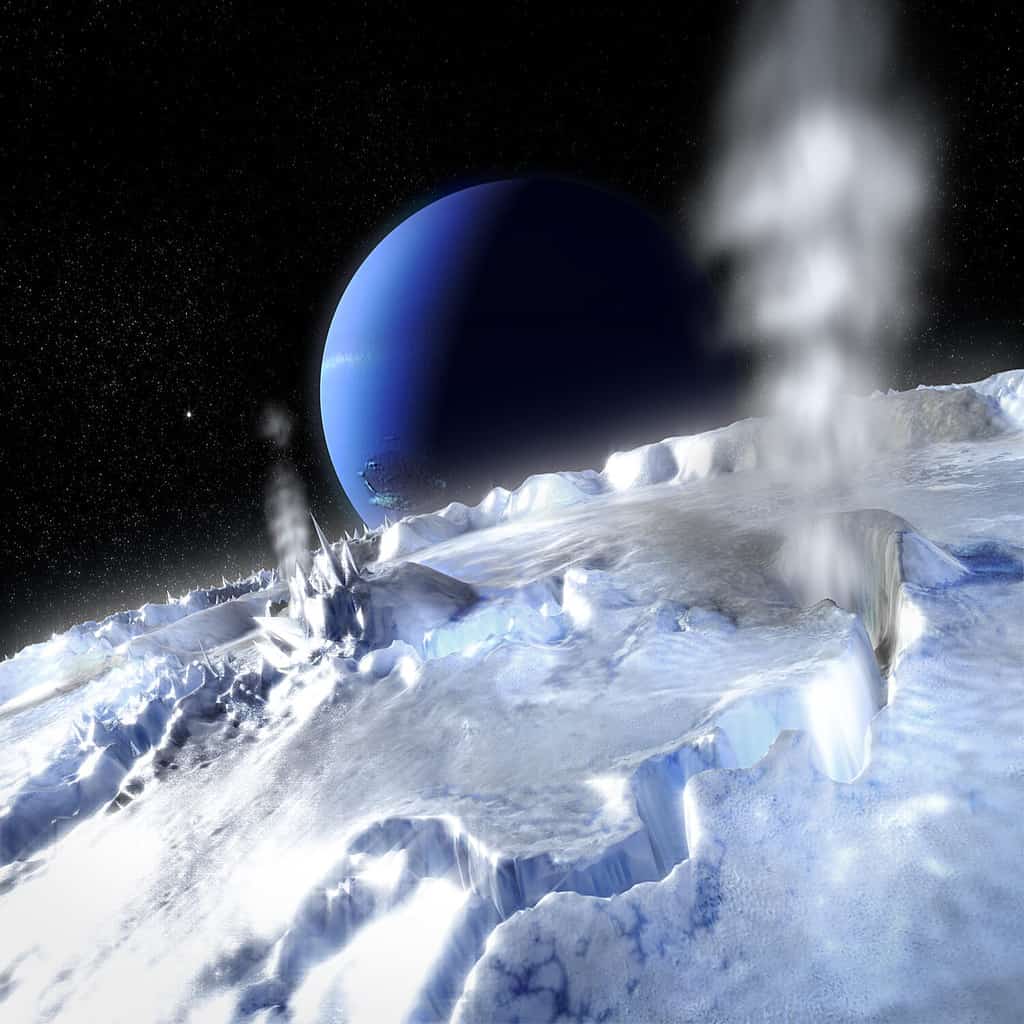Now that Pluto has been demoted from planethood, Neptune is the outermost planet of the Solar System. It is also the only planet not visible from Earth with the naked eye. It was discovered in 1846 by mathematical calculations which were then verified by observations through a telescope. With its deep royal blue color, it seems appropriate that the planet has been named after the Roman sea god. We have learned a lot about Neptune since its discovery, including details of its chemical composition. So just what is Neptune made of? And does its striking blue color mean that it actually is a real Waterworld?

The planet Neptune was named after the Roman god of the sea.
©Zwiebackesser/Shutterstock.com

Neptune is shades of deep, brilliant blue that looks like a planet-wide ocean of water.
©iStock.com/PandaWild
Description of Neptune
Size
Neptune is 34,503 miles in diameter, or about four times wider than Earth. That may not sound that big. However, if Neptune were the size of a baseball, our planet would be only as big as a nickel. And the volume inside it is so huge, 57 Earths could fit inside it! The diameter of Neptune also makes it the smallest of the giant planets (Jupiter, Saturn, Uranus, and Neptune). But even though Uranus is larger in diameter, it has less mass than Neptune.

Neptune, top left, is the fourth-largest planet in the Solar System.
©iStock.com/buradaki
Orbit and distance
Like the orbits of the other planets, Neptune’s orbit is an ellipse, not a perfect circle. It takes 165 years to make one trip around the Sun. In 2011, it finally completed one orbit (one Neptune-year) since its discovery in 1846. It does spin faster than Earth, though, meaning one Neptune day is only 16 hours long. On average, Neptune is about 2.8 billion miles away from the Sun. An astronomical unit (AU) is the distance from the Sun to the Earth. By this measure, Neptune is 30 AUs from the Sun; 30 times further away than the Earth. Light from our Sun takes a little over eight minutes to reach Earth, but it takes four hours to reach Neptune! Sunlight at noon from that distance is 900 times dimmer than it is on Earth. It might look like evening time to us.

Noon on Neptune might be as bright as twilight on Earth, like this evening Thailand sky.
©PANO360/Shutterstock.com
Weather
Neptune is tilted by 28 degrees with respect to the Sun, which is similar to the orbits of Mars and Earth. This gives Neptune four seasons, but each season is over 40 years long. Imagine what this would be like on Earth. Someone who lived a full lifespan might experience only two of the four seasons as an adult. And a lot of adults would be very upset if they never got their pumpkin spice latte!
Wind
Neptune has the highest wind speeds of any planet in the Solar System, reaching over 1,200 miles per hour. In comparison, the fastest wind speed on Earth was 302 miles per hour in an Oklahoma F5 tornado. So, every day on Neptune is like being in a tornado four times stronger than the strongest ever measured in our world! From time to time, dark oval-shaped spots similar to Jupiter’s Great Red Spot form in Neptune’s atmosphere. They then disappear after a while. One that was photographed by Voyager 2 in 1989 disappeared five years later. However, while it lasted, it was bigger than planet Earth. Scientists think these spots are holes in the upper atmospheric clouds that reveal darker, lower levels of the atmosphere.
The weather is so violent on Neptune because of the planet’s extreme temperature differences. At the point of the atmosphere where the pressure is comparable to Earth, the temperature reaches a high of only 330°F. In contrast, Neptune’s core blazes at 12,632°F, twice the temperature of the surface of the Sun! The planet’s water layer grows increasingly hot and pressurized the closer it is to that hot core. This extreme heat difference drives the insanely violent winds, as temperatures circulate from the core up to the sub-freezing atmosphere.

The wind speeds on Neptune are four times faster than the fastest tornado winds on Earth.
©solarseven/Shutterstock.com
Moons and Rings
We currently know of 14 moons of Neptune. The largest, Triton, was discovered just a few days after the planet was discovered. It was named after the mythological sea god’s son. Inexplicably, it rotates opposite to the direction of every other moon and planet in the Solar System. Scientists think it may be a captured object rather than something that formed along with the planet. It is frozen, but warming up and it shoots five-mile-high ice geysers into space. Like Triton, all the moons in the Neptunian system were named after mythological gods and nymphs associated with the sea.
In 1989, Voyager 2 became the only space probe ever to get an up-close look at Neptune. Five years before, ground-based astronomers discovered the planet had “arcs” around it. Voyager 2 was able to photograph them. The photos showed Neptune has five complete rings and four ring arcs with material clumped together rather than spread out into even rings. Astronomers think these arcs stay in this unusual configuration because of the gravity of one of Neptune’s moons.

In this artist’s conception, icy geysers erupt from the surface of Neptune’s frozen largest moon, Triton.
©Simon Wendler/Shutterstock.com
What is Neptune Made Of?
So, what exactly is Neptune made of? Does it get its bright blue color from water? Inside Neptune is a small rocky core about the size of Earth that some researchers think formed in the inner Solar System, before moving out to Neptune’s present orbit, gathering more material along the way. In its present state, 80% of the planet’s mass is made of water, hydrogen, helium, methane, and ammonia.
So yes, Neptune does have water. A lot of it. A huge enormously deep ocean of it, thicker than the diameter of the whole Earth. But hold your horses; that’s not why Neptune looks blue. That water is mostly hidden much deeper within the planet under tremendous heat and pressure in a supercritical state, which means it is neither a fluid nor a gas, but something in between. But above that is a thick atmosphere made of hydrogen, helium, methane, ammonia, and other gasses. Like Uranus, Neptune looks blue mainly because of its methane, not because of its water. It is a more vibrant shade of blue than Uranus for reasons that are not fully understood.

Neptune is without a doubt one of the most gorgeous planets in the Solar System.
©iStock.com/3quarks
What Other Wonders Await?
Neptune is entirely invisible to our eyes, but we figured out that it existed through math. Before it could complete one full orbit, we had seen it through telescopes and built a spacecraft to take pictures of it. What other wonders await us in the 165-year Neptune-year ahead? In a century, will our descendants take a space cruise there and see it from their bedroom windows? Will they work on mining operations or scientific stations on Neptune’s moons?
We’re already detecting planets around other stars. With the assistance of increasingly sophisticated computer technology, will we find a way to see them up close as well? And will any of them be more beautiful than the ones we have already seen?
The universe is full of surprises. What we have already discovered is just a small taste of the unimaginable wonders that await us!
The photo featured at the top of this post is © NASA images/Shutterstock.com
Thank you for reading! Have some feedback for us? Contact the AZ Animals editorial team.






